Strategic Management and Leadership Report: Samsung's Success
VerifiedAdded on 2022/08/28
|29
|6457
|29
Report
AI Summary
This report provides a comprehensive analysis of Samsung's strategic management and leadership. It begins with an overview of the company, its nature of business, and the challenges it faces. The report then defines and measures Samsung's success using a balanced scorecard, considering financial, customer, and staff satisfaction perspectives. It explores the reasons behind Samsung's success, including its mission statement, management contributions, innovations, and marketing strategies. Internal analysis includes a value chain analysis and VRIN analysis of inbound logistics, outbound logistics, operations, marketing, services, and R&D. The report examines the contribution of leaders and reviews the company's competitive and growth strategies using Porter's model and the Ansoff Matrix. Finally, it analyzes Samsung's future prospects, considering expected growth, PEST factors, and Porter's Five Forces, concluding with a summary of key findings and recommendations.
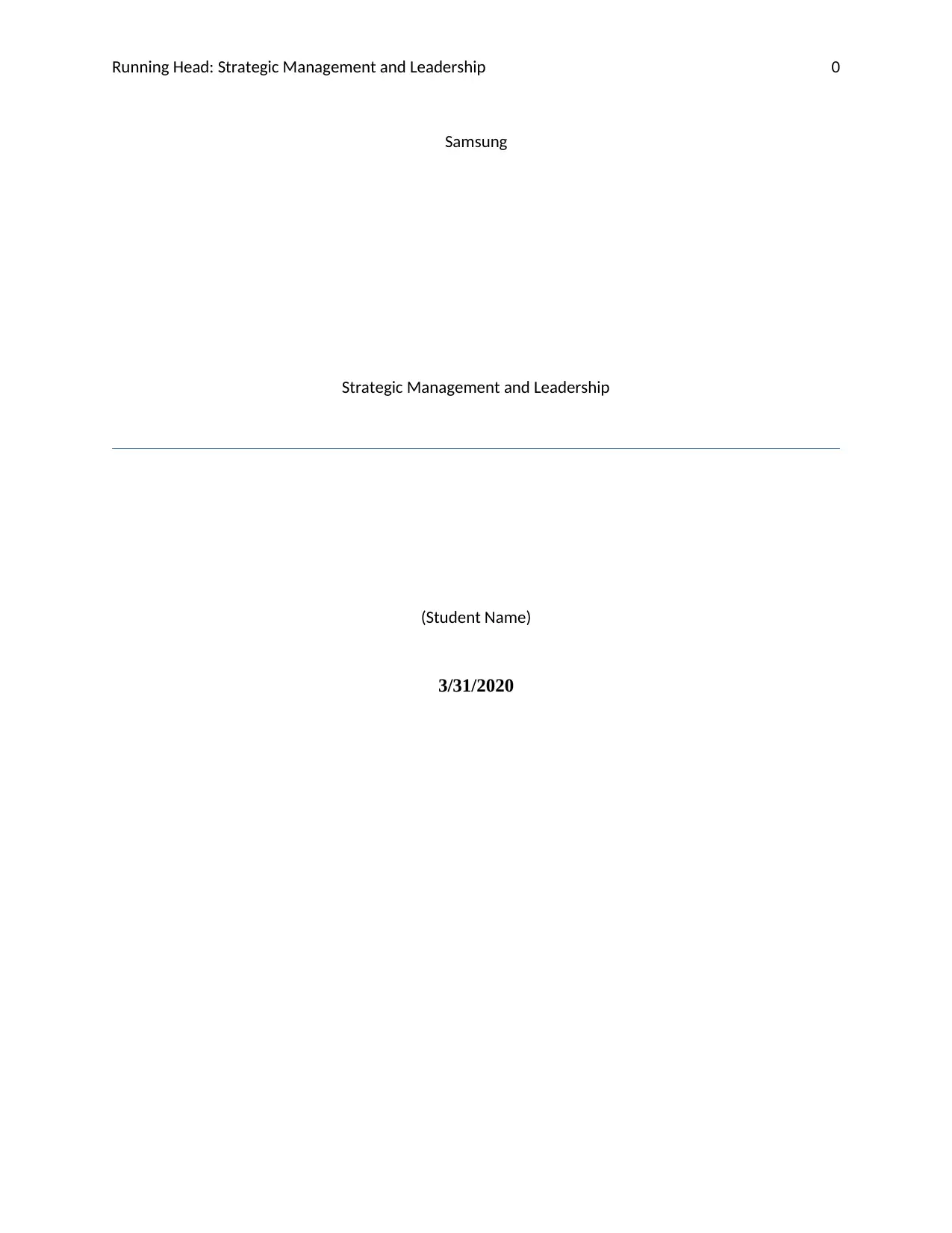
Running Head: Strategic Management and Leadership 0
Samsung
Strategic Management and Leadership
(Student Name)
3/31/2020
Samsung
Strategic Management and Leadership
(Student Name)
3/31/2020
Paraphrase This Document
Need a fresh take? Get an instant paraphrase of this document with our AI Paraphraser
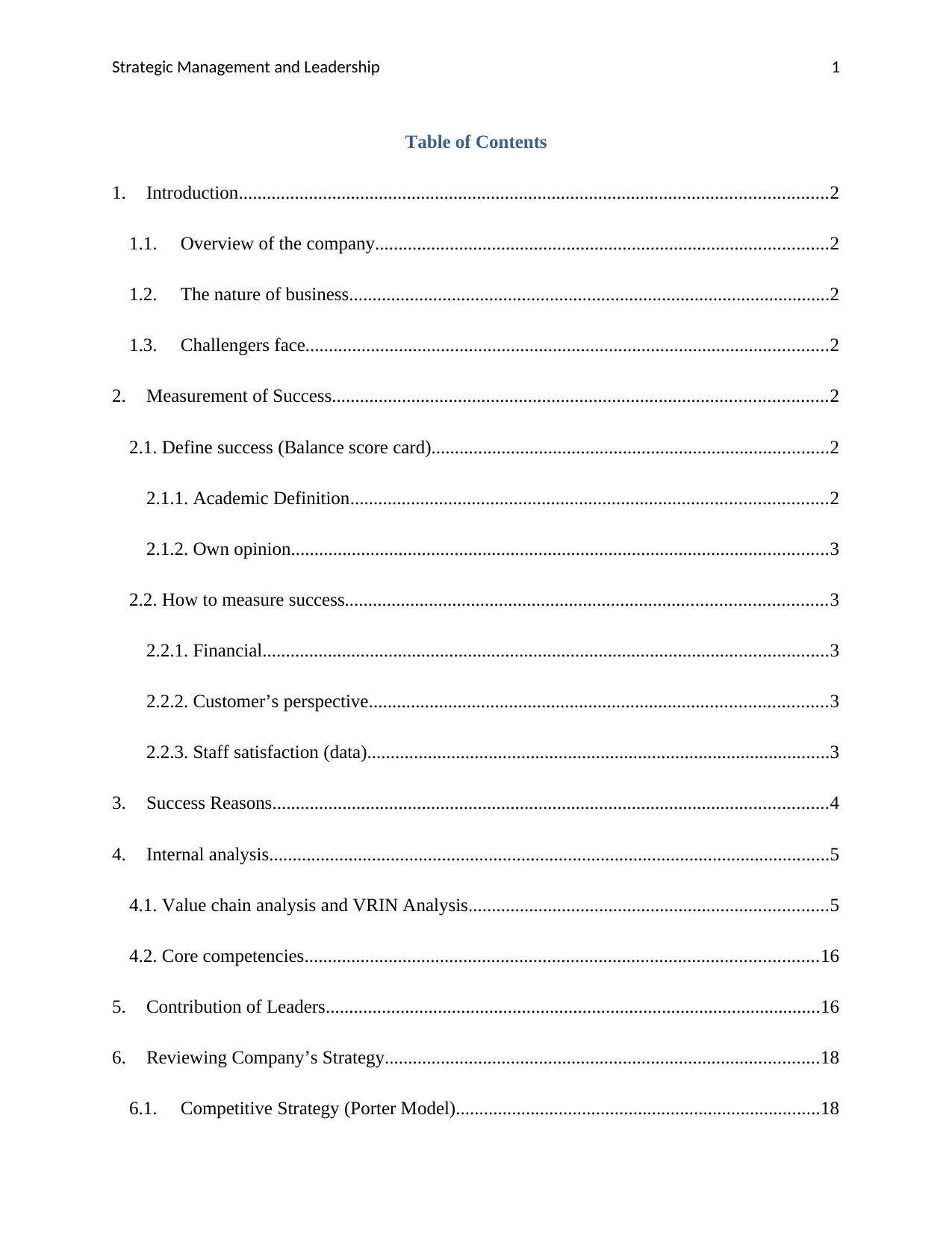
Strategic Management and Leadership 1
Table of Contents
1. Introduction..............................................................................................................................2
1.1. Overview of the company.................................................................................................2
1.2. The nature of business.......................................................................................................2
1.3. Challengers face................................................................................................................2
2. Measurement of Success..........................................................................................................2
2.1. Define success (Balance score card).....................................................................................2
2.1.1. Academic Definition......................................................................................................2
2.1.2. Own opinion...................................................................................................................3
2.2. How to measure success.......................................................................................................3
2.2.1. Financial.........................................................................................................................3
2.2.2. Customer’s perspective..................................................................................................3
2.2.3. Staff satisfaction (data)...................................................................................................3
3. Success Reasons.......................................................................................................................4
4. Internal analysis........................................................................................................................5
4.1. Value chain analysis and VRIN Analysis.............................................................................5
4.2. Core competencies..............................................................................................................16
5. Contribution of Leaders..........................................................................................................16
6. Reviewing Company’s Strategy.............................................................................................18
6.1. Competitive Strategy (Porter Model)..............................................................................18
Table of Contents
1. Introduction..............................................................................................................................2
1.1. Overview of the company.................................................................................................2
1.2. The nature of business.......................................................................................................2
1.3. Challengers face................................................................................................................2
2. Measurement of Success..........................................................................................................2
2.1. Define success (Balance score card).....................................................................................2
2.1.1. Academic Definition......................................................................................................2
2.1.2. Own opinion...................................................................................................................3
2.2. How to measure success.......................................................................................................3
2.2.1. Financial.........................................................................................................................3
2.2.2. Customer’s perspective..................................................................................................3
2.2.3. Staff satisfaction (data)...................................................................................................3
3. Success Reasons.......................................................................................................................4
4. Internal analysis........................................................................................................................5
4.1. Value chain analysis and VRIN Analysis.............................................................................5
4.2. Core competencies..............................................................................................................16
5. Contribution of Leaders..........................................................................................................16
6. Reviewing Company’s Strategy.............................................................................................18
6.1. Competitive Strategy (Porter Model)..............................................................................18
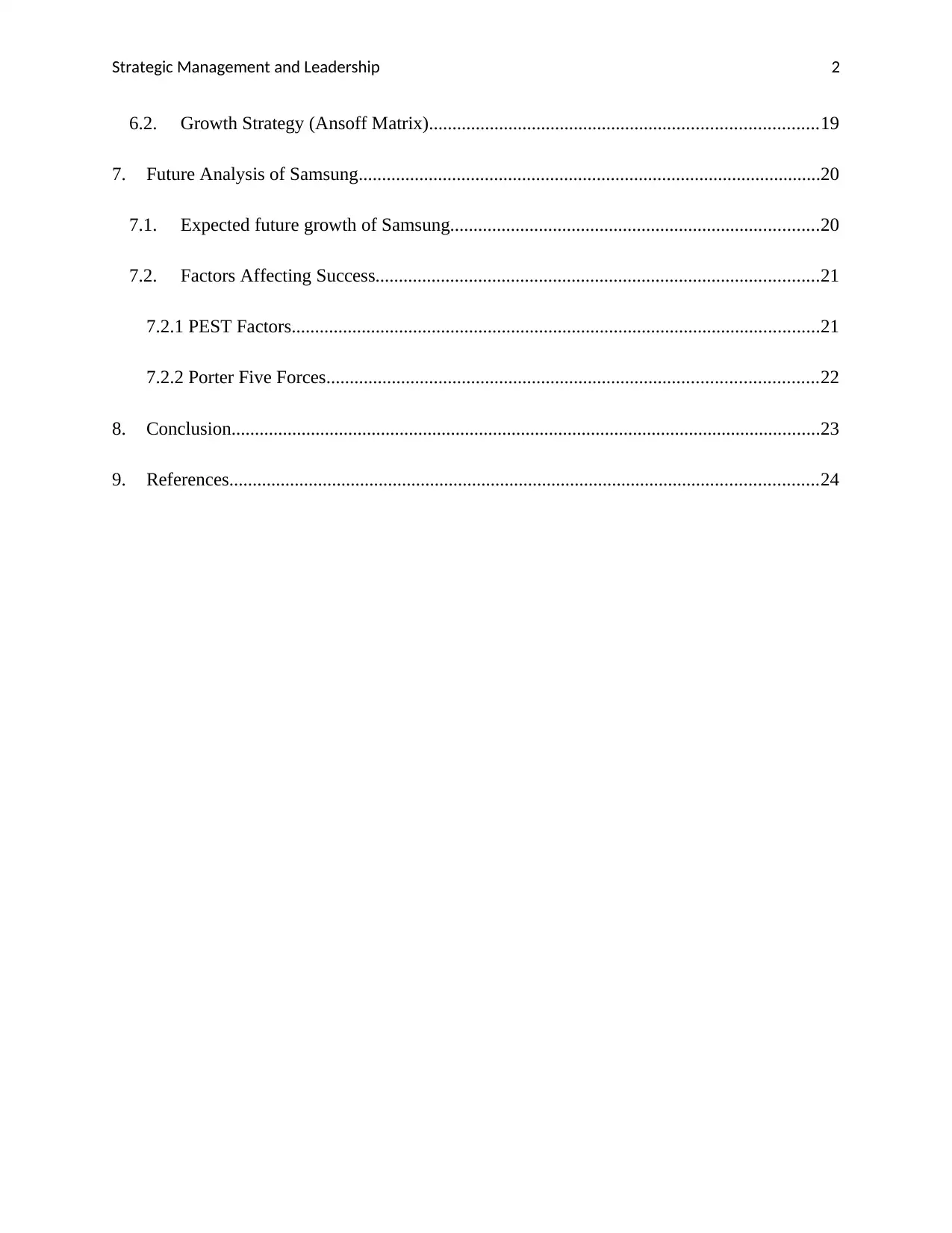
Strategic Management and Leadership 2
6.2. Growth Strategy (Ansoff Matrix)...................................................................................19
7. Future Analysis of Samsung...................................................................................................20
7.1. Expected future growth of Samsung...............................................................................20
7.2. Factors Affecting Success...............................................................................................21
7.2.1 PEST Factors.................................................................................................................21
7.2.2 Porter Five Forces.........................................................................................................22
8. Conclusion..............................................................................................................................23
9. References..............................................................................................................................24
6.2. Growth Strategy (Ansoff Matrix)...................................................................................19
7. Future Analysis of Samsung...................................................................................................20
7.1. Expected future growth of Samsung...............................................................................20
7.2. Factors Affecting Success...............................................................................................21
7.2.1 PEST Factors.................................................................................................................21
7.2.2 Porter Five Forces.........................................................................................................22
8. Conclusion..............................................................................................................................23
9. References..............................................................................................................................24
⊘ This is a preview!⊘
Do you want full access?
Subscribe today to unlock all pages.

Trusted by 1+ million students worldwide
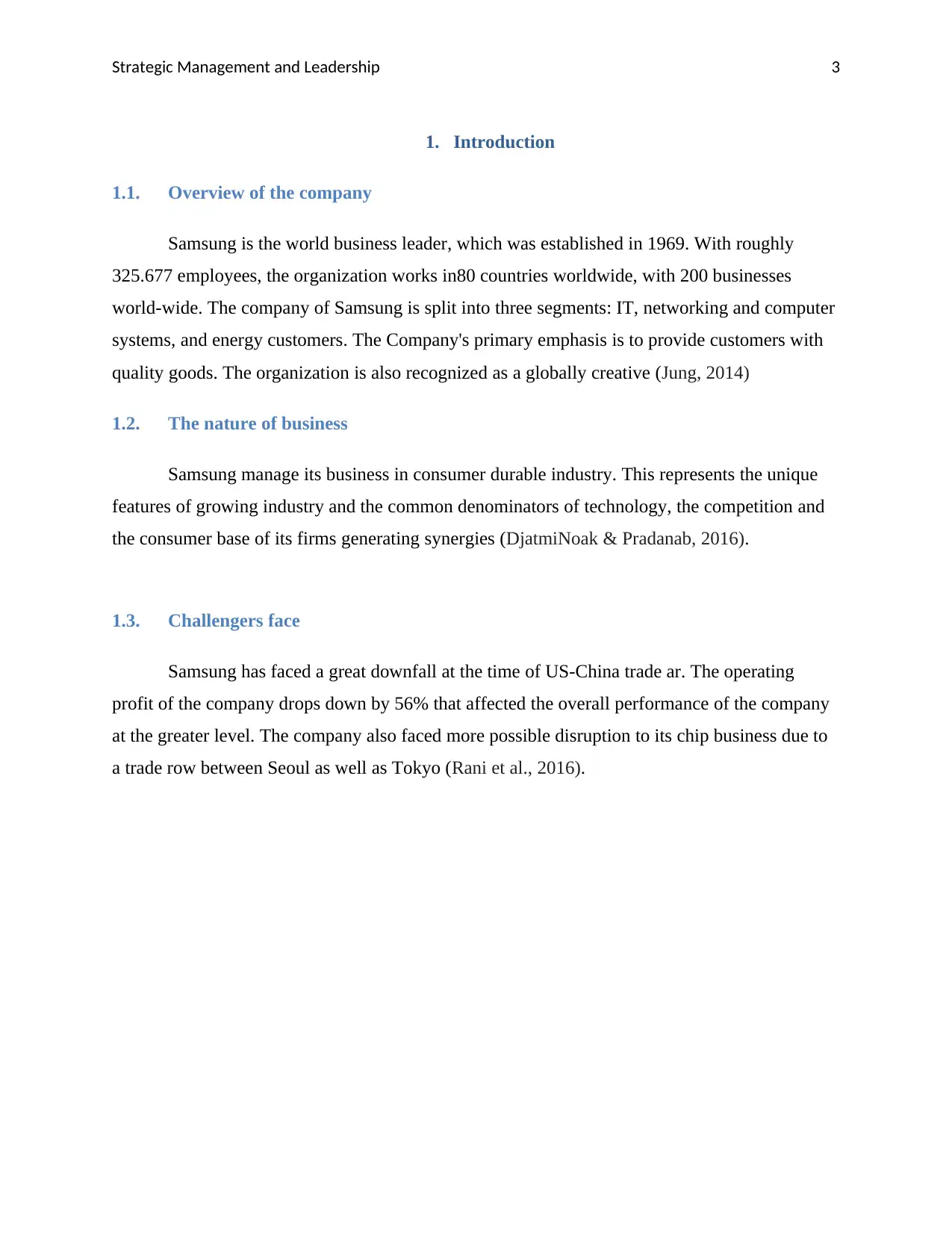
Strategic Management and Leadership 3
1. Introduction
1.1. Overview of the company
Samsung is the world business leader, which was established in 1969. With roughly
325.677 employees, the organization works in80 countries worldwide, with 200 businesses
world-wide. The company of Samsung is split into three segments: IT, networking and computer
systems, and energy customers. The Company's primary emphasis is to provide customers with
quality goods. The organization is also recognized as a globally creative (Jung, 2014)
1.2. The nature of business
Samsung manage its business in consumer durable industry. This represents the unique
features of growing industry and the common denominators of technology, the competition and
the consumer base of its firms generating synergies (DjatmiNoak & Pradanab, 2016).
1.3. Challengers face
Samsung has faced a great downfall at the time of US-China trade ar. The operating
profit of the company drops down by 56% that affected the overall performance of the company
at the greater level. The company also faced more possible disruption to its chip business due to
a trade row between Seoul as well as Tokyo (Rani et al., 2016).
1. Introduction
1.1. Overview of the company
Samsung is the world business leader, which was established in 1969. With roughly
325.677 employees, the organization works in80 countries worldwide, with 200 businesses
world-wide. The company of Samsung is split into three segments: IT, networking and computer
systems, and energy customers. The Company's primary emphasis is to provide customers with
quality goods. The organization is also recognized as a globally creative (Jung, 2014)
1.2. The nature of business
Samsung manage its business in consumer durable industry. This represents the unique
features of growing industry and the common denominators of technology, the competition and
the consumer base of its firms generating synergies (DjatmiNoak & Pradanab, 2016).
1.3. Challengers face
Samsung has faced a great downfall at the time of US-China trade ar. The operating
profit of the company drops down by 56% that affected the overall performance of the company
at the greater level. The company also faced more possible disruption to its chip business due to
a trade row between Seoul as well as Tokyo (Rani et al., 2016).
Paraphrase This Document
Need a fresh take? Get an instant paraphrase of this document with our AI Paraphraser
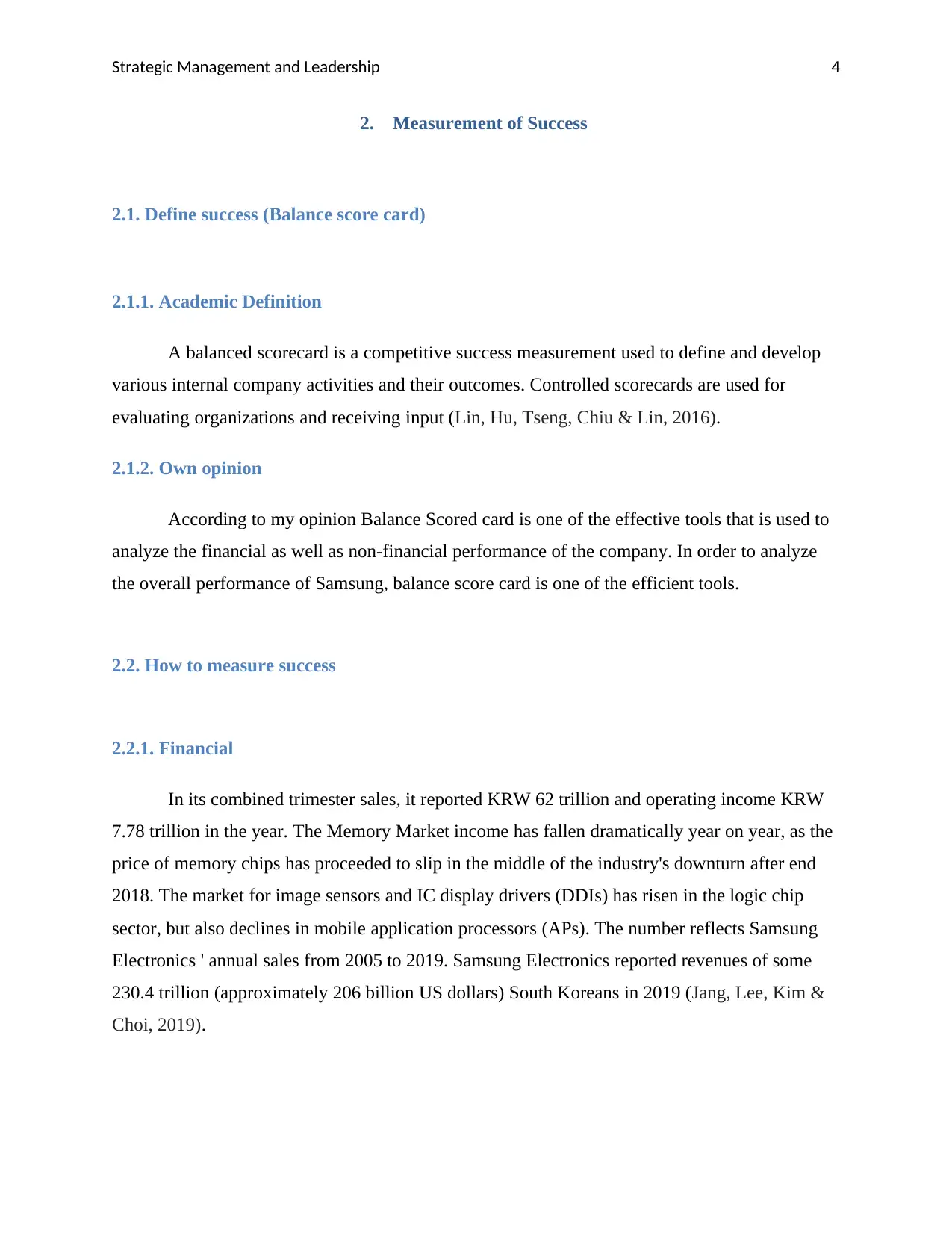
Strategic Management and Leadership 4
2. Measurement of Success
2.1. Define success (Balance score card)
2.1.1. Academic Definition
A balanced scorecard is a competitive success measurement used to define and develop
various internal company activities and their outcomes. Controlled scorecards are used for
evaluating organizations and receiving input (Lin, Hu, Tseng, Chiu & Lin, 2016).
2.1.2. Own opinion
According to my opinion Balance Scored card is one of the effective tools that is used to
analyze the financial as well as non-financial performance of the company. In order to analyze
the overall performance of Samsung, balance score card is one of the efficient tools.
2.2. How to measure success
2.2.1. Financial
In its combined trimester sales, it reported KRW 62 trillion and operating income KRW
7.78 trillion in the year. The Memory Market income has fallen dramatically year on year, as the
price of memory chips has proceeded to slip in the middle of the industry's downturn after end
2018. The market for image sensors and IC display drivers (DDIs) has risen in the logic chip
sector, but also declines in mobile application processors (APs). The number reflects Samsung
Electronics ' annual sales from 2005 to 2019. Samsung Electronics reported revenues of some
230.4 trillion (approximately 206 billion US dollars) South Koreans in 2019 (Jang, Lee, Kim &
Choi, 2019).
2. Measurement of Success
2.1. Define success (Balance score card)
2.1.1. Academic Definition
A balanced scorecard is a competitive success measurement used to define and develop
various internal company activities and their outcomes. Controlled scorecards are used for
evaluating organizations and receiving input (Lin, Hu, Tseng, Chiu & Lin, 2016).
2.1.2. Own opinion
According to my opinion Balance Scored card is one of the effective tools that is used to
analyze the financial as well as non-financial performance of the company. In order to analyze
the overall performance of Samsung, balance score card is one of the efficient tools.
2.2. How to measure success
2.2.1. Financial
In its combined trimester sales, it reported KRW 62 trillion and operating income KRW
7.78 trillion in the year. The Memory Market income has fallen dramatically year on year, as the
price of memory chips has proceeded to slip in the middle of the industry's downturn after end
2018. The market for image sensors and IC display drivers (DDIs) has risen in the logic chip
sector, but also declines in mobile application processors (APs). The number reflects Samsung
Electronics ' annual sales from 2005 to 2019. Samsung Electronics reported revenues of some
230.4 trillion (approximately 206 billion US dollars) South Koreans in 2019 (Jang, Lee, Kim &
Choi, 2019).
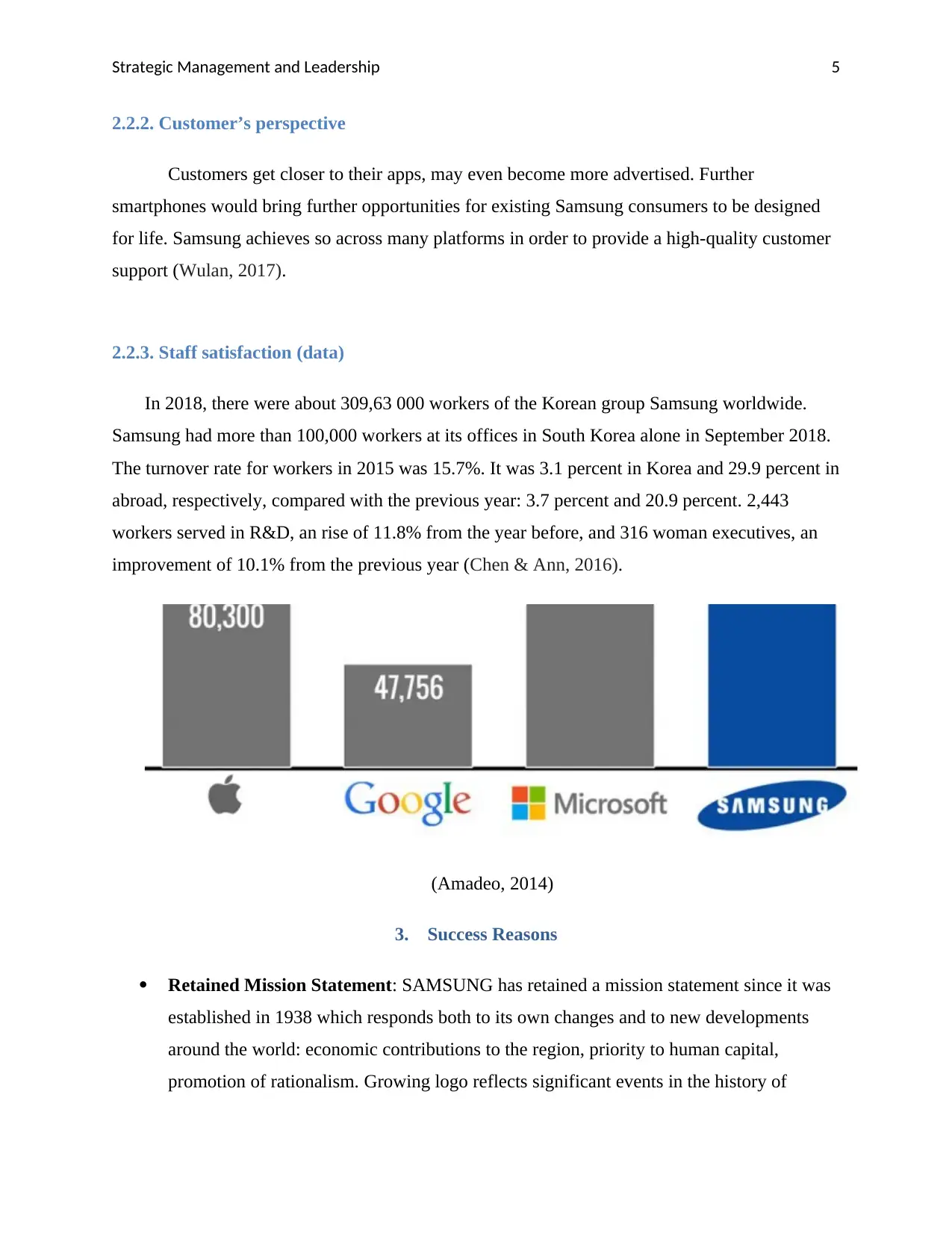
Strategic Management and Leadership 5
2.2.2. Customer’s perspective
Customers get closer to their apps, may even become more advertised. Further
smartphones would bring further opportunities for existing Samsung consumers to be designed
for life. Samsung achieves so across many platforms in order to provide a high-quality customer
support (Wulan, 2017).
2.2.3. Staff satisfaction (data)
In 2018, there were about 309,63 000 workers of the Korean group Samsung worldwide.
Samsung had more than 100,000 workers at its offices in South Korea alone in September 2018.
The turnover rate for workers in 2015 was 15.7%. It was 3.1 percent in Korea and 29.9 percent in
abroad, respectively, compared with the previous year: 3.7 percent and 20.9 percent. 2,443
workers served in R&D, an rise of 11.8% from the year before, and 316 woman executives, an
improvement of 10.1% from the previous year (Chen & Ann, 2016).
(Amadeo, 2014)
3. Success Reasons
Retained Mission Statement: SAMSUNG has retained a mission statement since it was
established in 1938 which responds both to its own changes and to new developments
around the world: economic contributions to the region, priority to human capital,
promotion of rationalism. Growing logo reflects significant events in the history of
2.2.2. Customer’s perspective
Customers get closer to their apps, may even become more advertised. Further
smartphones would bring further opportunities for existing Samsung consumers to be designed
for life. Samsung achieves so across many platforms in order to provide a high-quality customer
support (Wulan, 2017).
2.2.3. Staff satisfaction (data)
In 2018, there were about 309,63 000 workers of the Korean group Samsung worldwide.
Samsung had more than 100,000 workers at its offices in South Korea alone in September 2018.
The turnover rate for workers in 2015 was 15.7%. It was 3.1 percent in Korea and 29.9 percent in
abroad, respectively, compared with the previous year: 3.7 percent and 20.9 percent. 2,443
workers served in R&D, an rise of 11.8% from the year before, and 316 woman executives, an
improvement of 10.1% from the previous year (Chen & Ann, 2016).
(Amadeo, 2014)
3. Success Reasons
Retained Mission Statement: SAMSUNG has retained a mission statement since it was
established in 1938 which responds both to its own changes and to new developments
around the world: economic contributions to the region, priority to human capital,
promotion of rationalism. Growing logo reflects significant events in the history of
⊘ This is a preview!⊘
Do you want full access?
Subscribe today to unlock all pages.

Trusted by 1+ million students worldwide
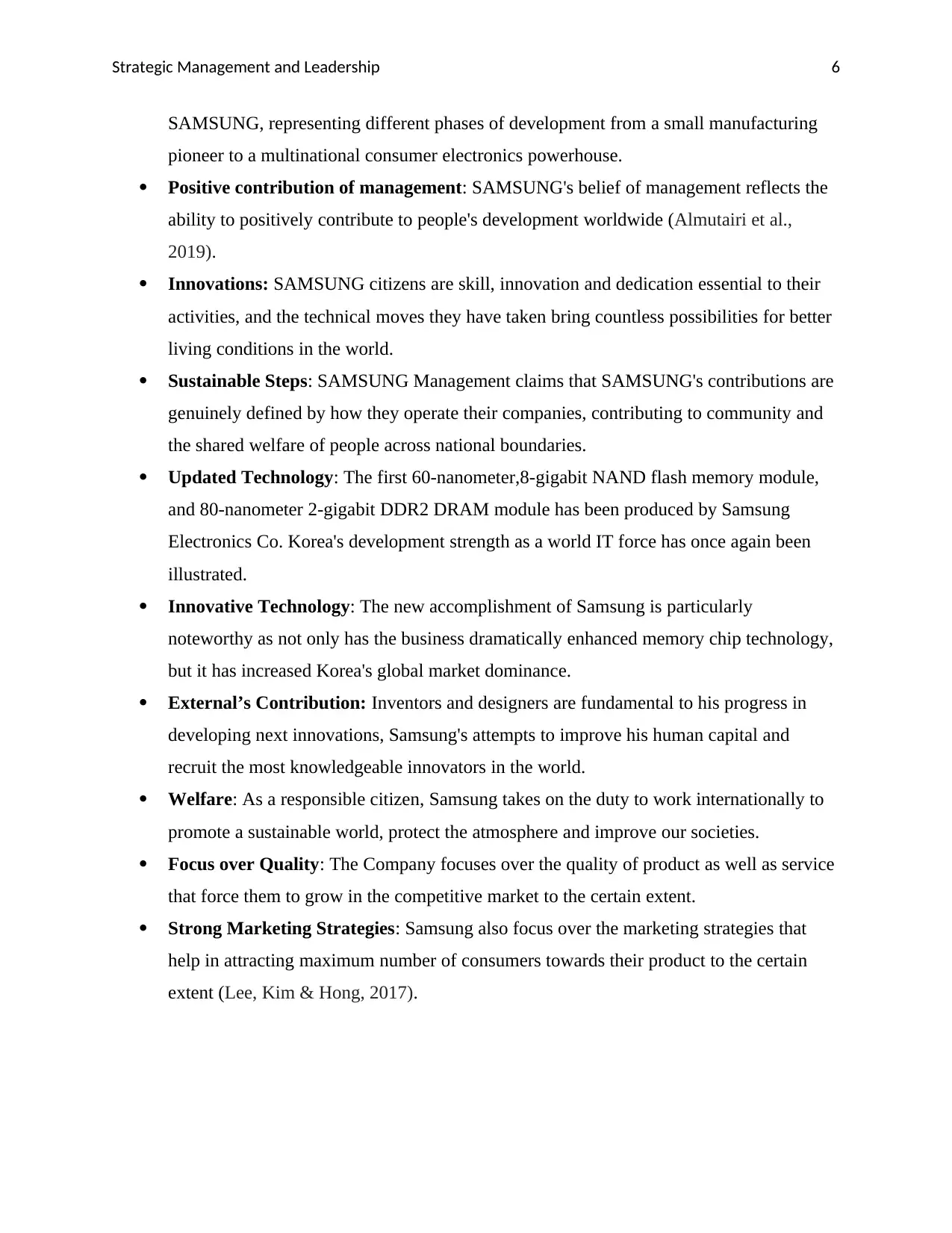
Strategic Management and Leadership 6
SAMSUNG, representing different phases of development from a small manufacturing
pioneer to a multinational consumer electronics powerhouse.
Positive contribution of management: SAMSUNG's belief of management reflects the
ability to positively contribute to people's development worldwide (Almutairi et al.,
2019).
Innovations: SAMSUNG citizens are skill, innovation and dedication essential to their
activities, and the technical moves they have taken bring countless possibilities for better
living conditions in the world.
Sustainable Steps: SAMSUNG Management claims that SAMSUNG's contributions are
genuinely defined by how they operate their companies, contributing to community and
the shared welfare of people across national boundaries.
Updated Technology: The first 60-nanometer,8-gigabit NAND flash memory module,
and 80-nanometer 2-gigabit DDR2 DRAM module has been produced by Samsung
Electronics Co. Korea's development strength as a world IT force has once again been
illustrated.
Innovative Technology: The new accomplishment of Samsung is particularly
noteworthy as not only has the business dramatically enhanced memory chip technology,
but it has increased Korea's global market dominance.
External’s Contribution: Inventors and designers are fundamental to his progress in
developing next innovations, Samsung's attempts to improve his human capital and
recruit the most knowledgeable innovators in the world.
Welfare: As a responsible citizen, Samsung takes on the duty to work internationally to
promote a sustainable world, protect the atmosphere and improve our societies.
Focus over Quality: The Company focuses over the quality of product as well as service
that force them to grow in the competitive market to the certain extent.
Strong Marketing Strategies: Samsung also focus over the marketing strategies that
help in attracting maximum number of consumers towards their product to the certain
extent (Lee, Kim & Hong, 2017).
SAMSUNG, representing different phases of development from a small manufacturing
pioneer to a multinational consumer electronics powerhouse.
Positive contribution of management: SAMSUNG's belief of management reflects the
ability to positively contribute to people's development worldwide (Almutairi et al.,
2019).
Innovations: SAMSUNG citizens are skill, innovation and dedication essential to their
activities, and the technical moves they have taken bring countless possibilities for better
living conditions in the world.
Sustainable Steps: SAMSUNG Management claims that SAMSUNG's contributions are
genuinely defined by how they operate their companies, contributing to community and
the shared welfare of people across national boundaries.
Updated Technology: The first 60-nanometer,8-gigabit NAND flash memory module,
and 80-nanometer 2-gigabit DDR2 DRAM module has been produced by Samsung
Electronics Co. Korea's development strength as a world IT force has once again been
illustrated.
Innovative Technology: The new accomplishment of Samsung is particularly
noteworthy as not only has the business dramatically enhanced memory chip technology,
but it has increased Korea's global market dominance.
External’s Contribution: Inventors and designers are fundamental to his progress in
developing next innovations, Samsung's attempts to improve his human capital and
recruit the most knowledgeable innovators in the world.
Welfare: As a responsible citizen, Samsung takes on the duty to work internationally to
promote a sustainable world, protect the atmosphere and improve our societies.
Focus over Quality: The Company focuses over the quality of product as well as service
that force them to grow in the competitive market to the certain extent.
Strong Marketing Strategies: Samsung also focus over the marketing strategies that
help in attracting maximum number of consumers towards their product to the certain
extent (Lee, Kim & Hong, 2017).
Paraphrase This Document
Need a fresh take? Get an instant paraphrase of this document with our AI Paraphraser
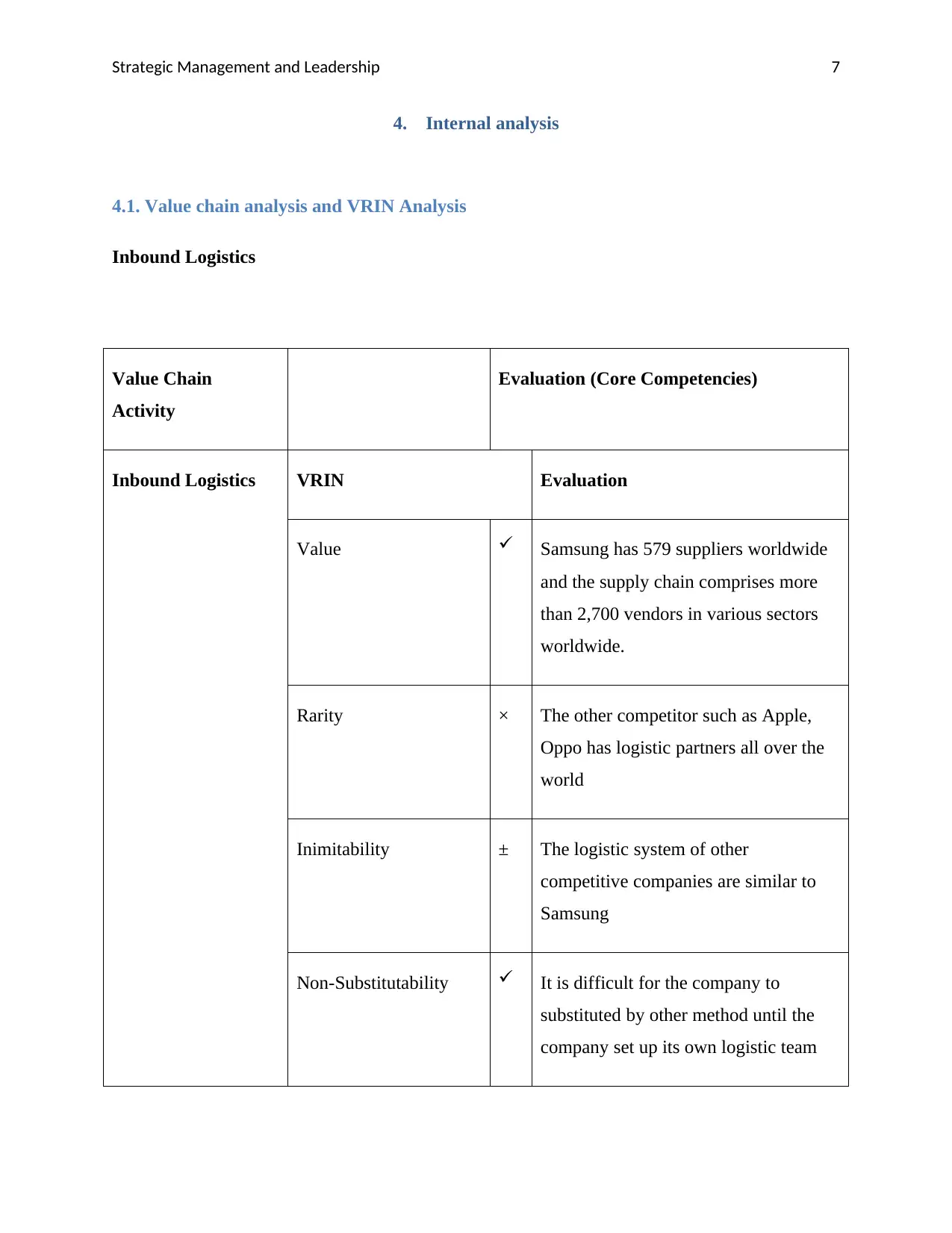
Strategic Management and Leadership 7
4. Internal analysis
4.1. Value chain analysis and VRIN Analysis
Inbound Logistics
Value Chain
Activity
Evaluation (Core Competencies)
Inbound Logistics VRIN Evaluation
Value Samsung has 579 suppliers worldwide
and the supply chain comprises more
than 2,700 vendors in various sectors
worldwide.
Rarity × The other competitor such as Apple,
Oppo has logistic partners all over the
world
Inimitability ± The logistic system of other
competitive companies are similar to
Samsung
Non-Substitutability It is difficult for the company to
substituted by other method until the
company set up its own logistic team
4. Internal analysis
4.1. Value chain analysis and VRIN Analysis
Inbound Logistics
Value Chain
Activity
Evaluation (Core Competencies)
Inbound Logistics VRIN Evaluation
Value Samsung has 579 suppliers worldwide
and the supply chain comprises more
than 2,700 vendors in various sectors
worldwide.
Rarity × The other competitor such as Apple,
Oppo has logistic partners all over the
world
Inimitability ± The logistic system of other
competitive companies are similar to
Samsung
Non-Substitutability It is difficult for the company to
substituted by other method until the
company set up its own logistic team
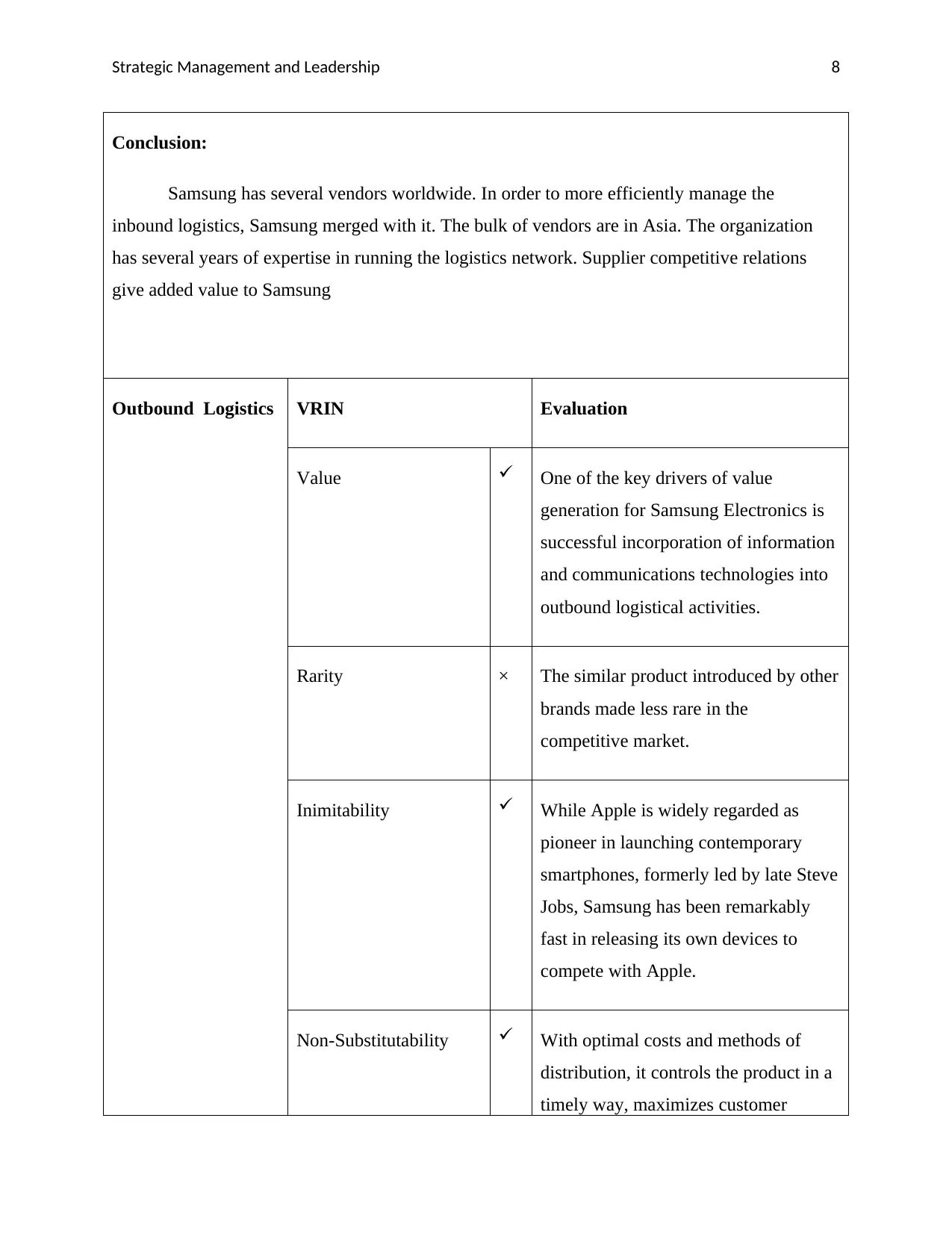
Strategic Management and Leadership 8
Conclusion:
Samsung has several vendors worldwide. In order to more efficiently manage the
inbound logistics, Samsung merged with it. The bulk of vendors are in Asia. The organization
has several years of expertise in running the logistics network. Supplier competitive relations
give added value to Samsung
Outbound Logistics VRIN Evaluation
Value One of the key drivers of value
generation for Samsung Electronics is
successful incorporation of information
and communications technologies into
outbound logistical activities.
Rarity × The similar product introduced by other
brands made less rare in the
competitive market.
Inimitability While Apple is widely regarded as
pioneer in launching contemporary
smartphones, formerly led by late Steve
Jobs, Samsung has been remarkably
fast in releasing its own devices to
compete with Apple.
Non-Substitutability With optimal costs and methods of
distribution, it controls the product in a
timely way, maximizes customer
Conclusion:
Samsung has several vendors worldwide. In order to more efficiently manage the
inbound logistics, Samsung merged with it. The bulk of vendors are in Asia. The organization
has several years of expertise in running the logistics network. Supplier competitive relations
give added value to Samsung
Outbound Logistics VRIN Evaluation
Value One of the key drivers of value
generation for Samsung Electronics is
successful incorporation of information
and communications technologies into
outbound logistical activities.
Rarity × The similar product introduced by other
brands made less rare in the
competitive market.
Inimitability While Apple is widely regarded as
pioneer in launching contemporary
smartphones, formerly led by late Steve
Jobs, Samsung has been remarkably
fast in releasing its own devices to
compete with Apple.
Non-Substitutability With optimal costs and methods of
distribution, it controls the product in a
timely way, maximizes customer
⊘ This is a preview!⊘
Do you want full access?
Subscribe today to unlock all pages.

Trusted by 1+ million students worldwide
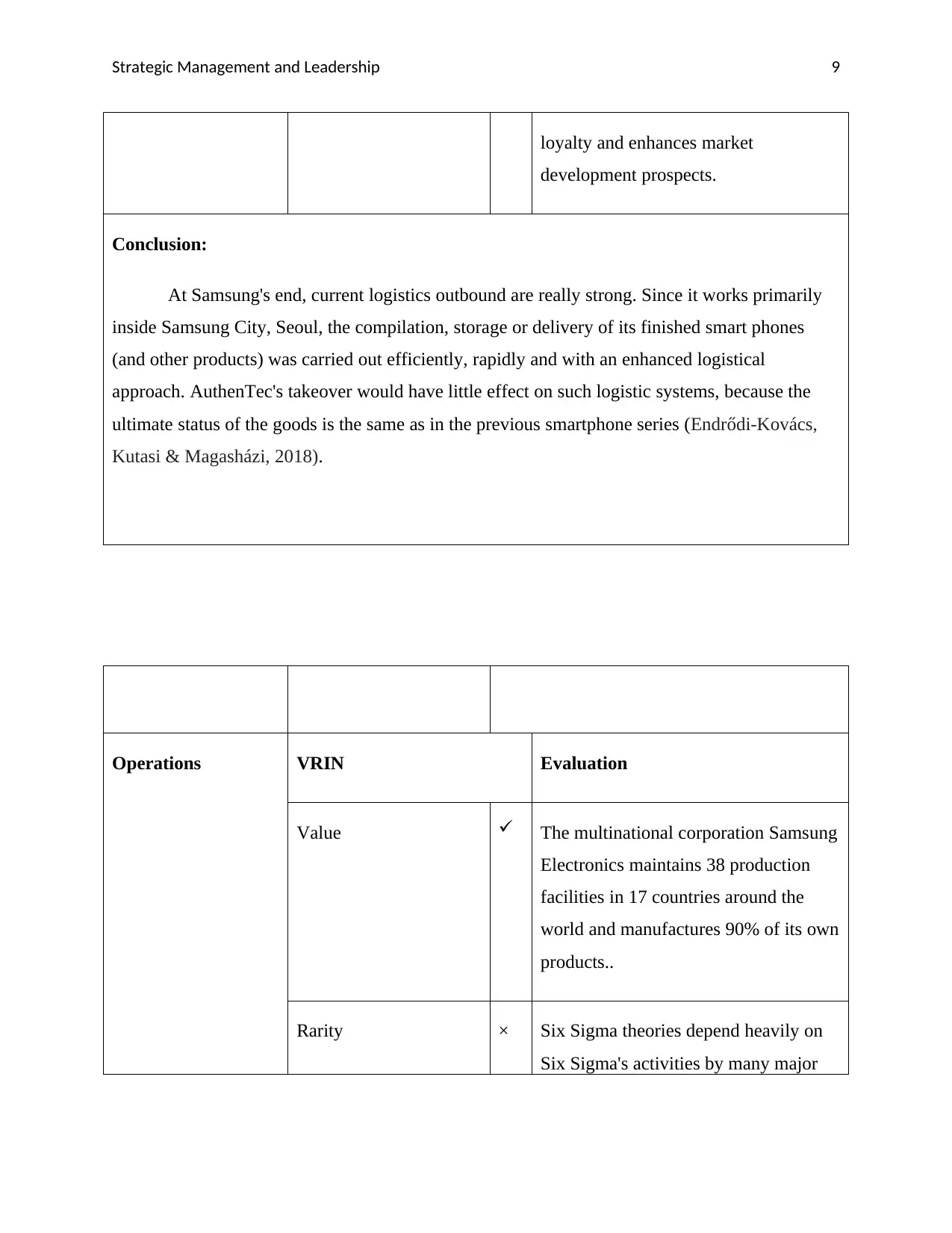
Strategic Management and Leadership 9
loyalty and enhances market
development prospects.
Conclusion:
At Samsung's end, current logistics outbound are really strong. Since it works primarily
inside Samsung City, Seoul, the compilation, storage or delivery of its finished smart phones
(and other products) was carried out efficiently, rapidly and with an enhanced logistical
approach. AuthenTec's takeover would have little effect on such logistic systems, because the
ultimate status of the goods is the same as in the previous smartphone series (Endrődi-Kovács,
Kutasi & Magasházi, 2018).
Operations VRIN Evaluation
Value The multinational corporation Samsung
Electronics maintains 38 production
facilities in 17 countries around the
world and manufactures 90% of its own
products..
Rarity × Six Sigma theories depend heavily on
Six Sigma's activities by many major
loyalty and enhances market
development prospects.
Conclusion:
At Samsung's end, current logistics outbound are really strong. Since it works primarily
inside Samsung City, Seoul, the compilation, storage or delivery of its finished smart phones
(and other products) was carried out efficiently, rapidly and with an enhanced logistical
approach. AuthenTec's takeover would have little effect on such logistic systems, because the
ultimate status of the goods is the same as in the previous smartphone series (Endrődi-Kovács,
Kutasi & Magasházi, 2018).
Operations VRIN Evaluation
Value The multinational corporation Samsung
Electronics maintains 38 production
facilities in 17 countries around the
world and manufactures 90% of its own
products..
Rarity × Six Sigma theories depend heavily on
Six Sigma's activities by many major
Paraphrase This Document
Need a fresh take? Get an instant paraphrase of this document with our AI Paraphraser
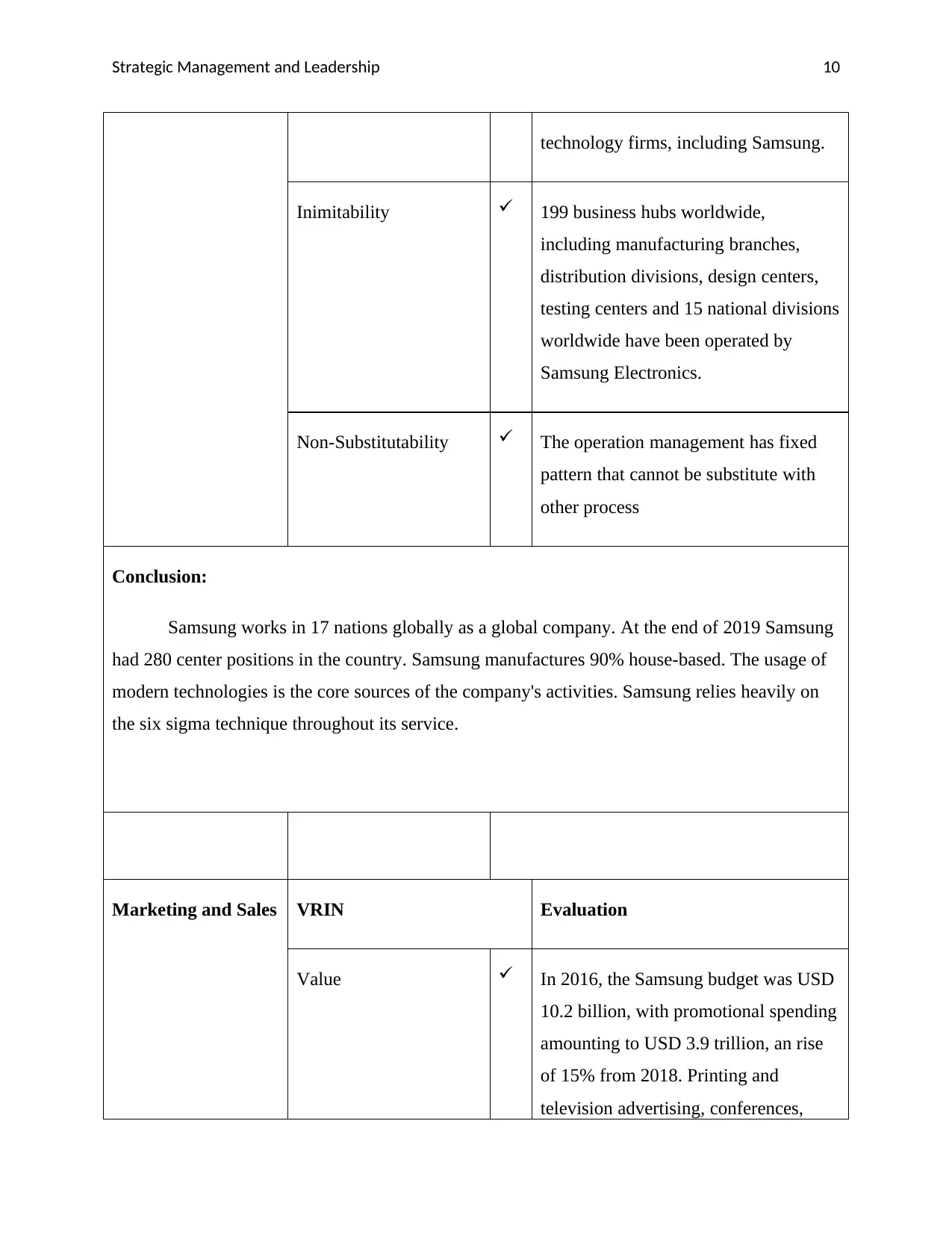
Strategic Management and Leadership 10
technology firms, including Samsung.
Inimitability 199 business hubs worldwide,
including manufacturing branches,
distribution divisions, design centers,
testing centers and 15 national divisions
worldwide have been operated by
Samsung Electronics.
Non-Substitutability The operation management has fixed
pattern that cannot be substitute with
other process
Conclusion:
Samsung works in 17 nations globally as a global company. At the end of 2019 Samsung
had 280 center positions in the country. Samsung manufactures 90% house-based. The usage of
modern technologies is the core sources of the company's activities. Samsung relies heavily on
the six sigma technique throughout its service.
Marketing and Sales VRIN Evaluation
Value In 2016, the Samsung budget was USD
10.2 billion, with promotional spending
amounting to USD 3.9 trillion, an rise
of 15% from 2018. Printing and
television advertising, conferences,
technology firms, including Samsung.
Inimitability 199 business hubs worldwide,
including manufacturing branches,
distribution divisions, design centers,
testing centers and 15 national divisions
worldwide have been operated by
Samsung Electronics.
Non-Substitutability The operation management has fixed
pattern that cannot be substitute with
other process
Conclusion:
Samsung works in 17 nations globally as a global company. At the end of 2019 Samsung
had 280 center positions in the country. Samsung manufactures 90% house-based. The usage of
modern technologies is the core sources of the company's activities. Samsung relies heavily on
the six sigma technique throughout its service.
Marketing and Sales VRIN Evaluation
Value In 2016, the Samsung budget was USD
10.2 billion, with promotional spending
amounting to USD 3.9 trillion, an rise
of 15% from 2018. Printing and
television advertising, conferences,
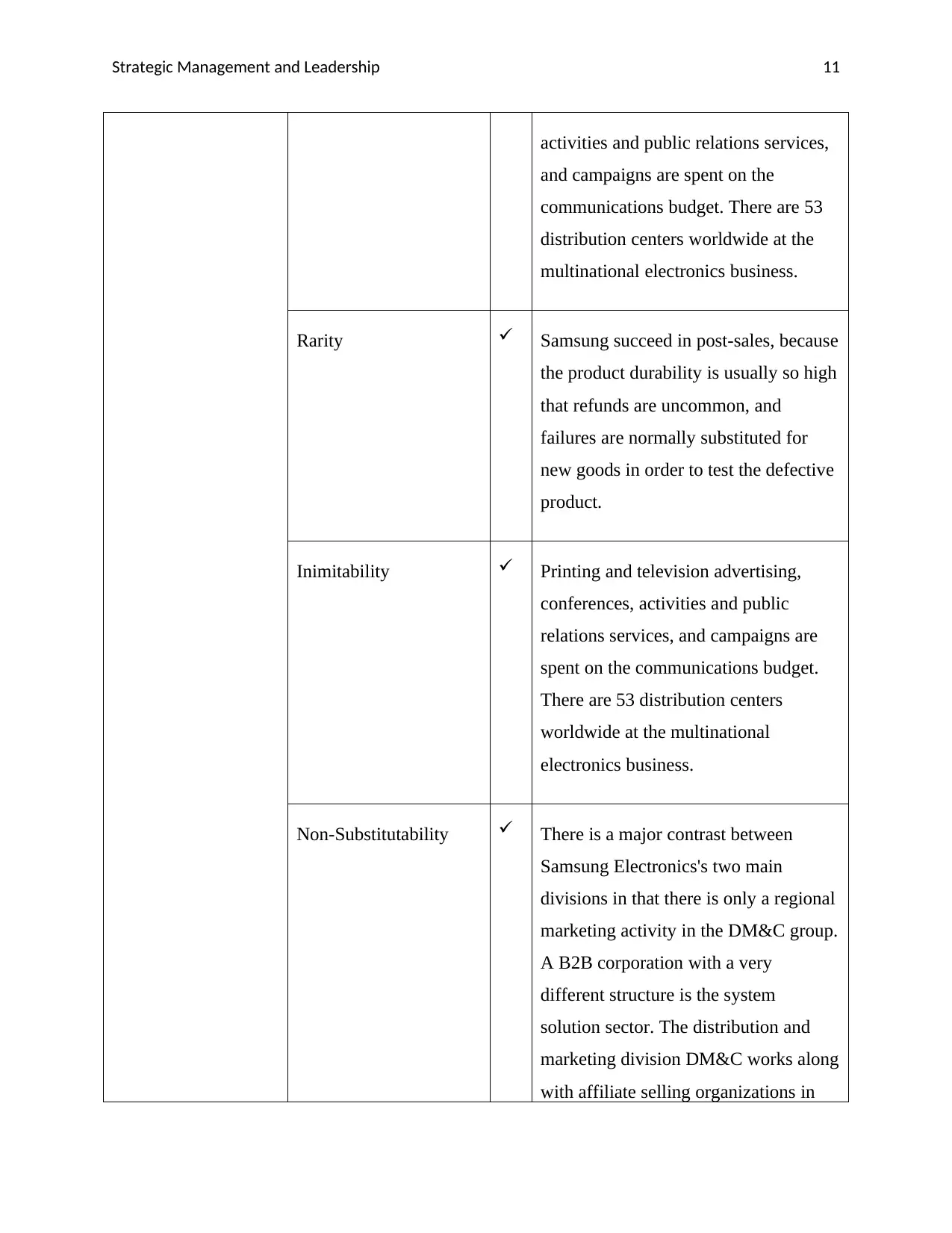
Strategic Management and Leadership 11
activities and public relations services,
and campaigns are spent on the
communications budget. There are 53
distribution centers worldwide at the
multinational electronics business.
Rarity Samsung succeed in post-sales, because
the product durability is usually so high
that refunds are uncommon, and
failures are normally substituted for
new goods in order to test the defective
product.
Inimitability Printing and television advertising,
conferences, activities and public
relations services, and campaigns are
spent on the communications budget.
There are 53 distribution centers
worldwide at the multinational
electronics business.
Non-Substitutability There is a major contrast between
Samsung Electronics's two main
divisions in that there is only a regional
marketing activity in the DM&C group.
A B2B corporation with a very
different structure is the system
solution sector. The distribution and
marketing division DM&C works along
with affiliate selling organizations in
activities and public relations services,
and campaigns are spent on the
communications budget. There are 53
distribution centers worldwide at the
multinational electronics business.
Rarity Samsung succeed in post-sales, because
the product durability is usually so high
that refunds are uncommon, and
failures are normally substituted for
new goods in order to test the defective
product.
Inimitability Printing and television advertising,
conferences, activities and public
relations services, and campaigns are
spent on the communications budget.
There are 53 distribution centers
worldwide at the multinational
electronics business.
Non-Substitutability There is a major contrast between
Samsung Electronics's two main
divisions in that there is only a regional
marketing activity in the DM&C group.
A B2B corporation with a very
different structure is the system
solution sector. The distribution and
marketing division DM&C works along
with affiliate selling organizations in
⊘ This is a preview!⊘
Do you want full access?
Subscribe today to unlock all pages.

Trusted by 1+ million students worldwide
1 out of 29
Related Documents
Your All-in-One AI-Powered Toolkit for Academic Success.
+13062052269
info@desklib.com
Available 24*7 on WhatsApp / Email
![[object Object]](/_next/static/media/star-bottom.7253800d.svg)
Unlock your academic potential
Copyright © 2020–2025 A2Z Services. All Rights Reserved. Developed and managed by ZUCOL.





